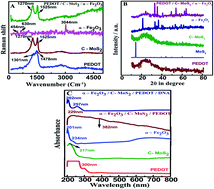DNA mediated electrocatalytic enhancement of α-Fe2O3–PEDOT–C-MoS2 hybrid nanostructures for riboflavin detection on screen printed electrode†
Abstract
A facile synthesis of iron oxide nanorods and PEDOT(poly(3,4-ethylenedioxythiophene)) nanospheres on carbon supported MoS2 (C-MoS2) is reported for riboflavin (RF) sensing. Furthermore, a novel aqueous-based DNA wrapped on an α-Fe2O3–PEDOT–C-MoS2 scaffold shows high electrocatalytic activity compared to that of the α-Fe2O3–PEDOT–C-MoS2 composite in biosensing. α-Fe2O3–PEDOT–C-MoS2/GCE demonstrates the linear response of RF in the concentration range from 800 nM to 700 μM, with a detection limit of 79 nM (S/N = 3σ/b), whereas the α-Fe2O3–PEDOT–C-MoS2–DNA/GCE composite shows a wider range from 300 nM to 1 mM with a comparatively low detection limit of 5 nM. Similarly, α-Fe2O3–PEDOT–C-MoS2–DNA/SPE exhibits a still wider range from 100 nM to 1 mM, with a detection limit of 12 nM. Interestingly, it is also observed that α-Fe2O3–PEDOT–C-MoS2–DNA/GCE reduces the oxidation potential of RF by 30 mV. Thus, the excellent behavior of the proposed biosensor can be attributed to the unique behavior of DNA, which provides a wider detection range and good electrocatalytic behavior towards RF. The fabricated sensor exhibited highly sensitive and selective detection of RF. Real sample analysis was also executed for human urine, milk powder and pharmaceutical drugs without any preliminary treatment.


 Please wait while we load your content...
Please wait while we load your content...